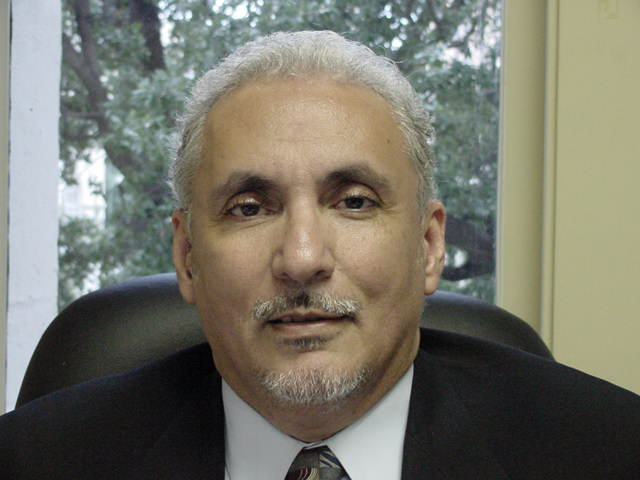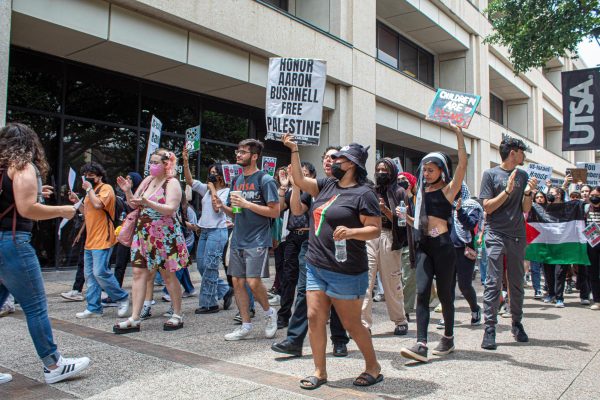Hispanic Excellence: UTSA lecturer commits to lifetime activism
Photo courtesy of Ruby Patterson
Photo courtesy of Ruby Patterson
September 28, 2021
Mario Marcel Salas grew up in San Antonio during a time of immense oppression and segregation. Salas attended a predominantly Black high school and mentioned that most of the hate he was exposed to was not necessarily in the school, but rather in the community.
“If I wanted to go to the movies it was segregated, so you had to go around to the back of the building. It also depended on the person at the front door. The person at the front door would do what I call a ‘visual vetting’ and they would look at you and say ‘his hair is too curly, go around to the back,’ ‘his skin is too dark, he looks Mexican, go around to the back. When we got inside the ushers escorted us upstairs because you couldn’t sit downstairs with the white people.”
In another instance, Salas describes a time when he and his father were getting on a bus, and the bus driver forced them to go to the back of the bus.
“People always say there have never been racial problems in San Antonio, but I’ll be damned,” Salas said. “It was horrible, so when people say stuff like that it’s a myth. The reality of it was you couldn’t go to a library, you had to go to a Black library, you couldn’t go to a swimming pool, they were white only and you couldn’t sit at the front of the bus if you were a person of color. For anyone to say that we didn’t have a racial problem in this town just doesn’t know what they are talking about.”
In high school, Salas began his activist career, where he was a part of a protest to shut the cafeteria down.
“When I got to high school, one of the first activities I was involved with was a protest against the cafeteria because there were flies in food,” Salas said. “I worked in the kitchen washing dishes and I would sit in the kitchen and watch the flies gather. It was horrible.”
In tandem with his fellow protest leaders, Salas urged students not to eat at the cafeteria until the school administration fixed the holes in the kitchen that were allowing flies in.
After high school, Salas attended San Antonio College, where he became involved in the Student Non-Violent Coordinating Committee (SNCC). The group served as a connection for students to become involved in the Civil Rights Movement. Some of their work included coordinating direct challenges to the segregation of African Americans.

“We went on to protest against the war in Vietnam, organized a Black student union, organized with a Mexican-American group, we had a coalition and we were fighting even back then for minority studies class,” Salas said. “In 1969, we were successful in getting a Black history class established. That was the first Black history class established in the city of San Antonio, at San Antonio Community College.”
Salas remains involved in fighting civil rights disputes around the city. He currently serves as the chairperson of the San Antonio Coalition for Police Accountability.
“San Antonio has an ugly history of policy abuse, and it’s still bad and we were working on police abuse issues way back when,” Salas said. “One of the cases that was pivotal was the case of Bobby Joe Philips. He was beaten to death by SA police officers and even though the medical examiner ruled his death a homicide, nothing ever happened to the police officers, they weren’t arrested, there was no indictment, nothing – they got away with murder. As a result, there were large demonstrations and I was very much involved with it and I still am.”
Later on, Salas developed a theory called the colonial matrix. He explained every American is raised with half-truths about how the United States functions and how it was formed. Therefore, racial myths are central to controlling the thought process of individuals and perpetuating false narratives of history and culture.
“Every discipline has a person of color, or woman who made an important contribution to that study, but under the rules of white supremacy it is erased,” Salas said. “There is no mention in a calculus book of the Black women who did the calculus for the Apollo spaceflight. The white supremacist matrix involves erasing people from the history books and implementing the mindset that anyone who is non-Western European becomes inferior. Skin color becomes the defining method by which to judge people, the defining mechanism that allows white supremacy to flourish. The legacy of white supremacy has a matrix that affects every aspect of life: education, social interactions, etc. Like a pandemic, it has infected every part of American society. Every ethnic group is collapsed into a racial matrix in order to implement the policies of white supremacy. In grouping these groups of people you erase their history.”
Salas went deeper into the gruesome history of white supremacy and how it developed into a matrix. Salas estimates the beginning of white supremacy during the defeat of the Moors in Spain in 1492.
“The Moors were dark-skinned African people and they defeated the Spaniards for 700 years, and brought with them their culture and language,” Salas said. “At the time most of Spain was Islamic and because the Moors were dark skinned Islamic people, so when the Moors defeated the light-skinned Spanish in the northern part of Spain it became an obsession in Spain that dark skin was to be hated. You can hypothesize quite quickly that the origin of racism is the result of Spanish colonialism and later on the English and during the enlightenment it became ‘scientific.’
To explain further, scientific racism, which was developed in the 1700’s, attempts to gather characteristics of an individual’s skin color, hair texture, bone structure, etc. and generate a “scientific” based hierarchy. The concept employs a representative heuristic that takes small numbers of a demographic and attempts to accurately portray it in its entirety with no consideration for nuance and individualism. Salas pointed to such a structure being a key perpetrator of white supremacy and the historical shift from religious belligerence to racial discomfort.
“It was only after scientific racism was developed that others with ethinic identities were placed into a box called ‘white’ and after white supremacy became scientific: then this matrix was created where all kinds of things evolved from it,” Salas said.
“For example, the U.S Constitution enshrines the first amendment, freedom of religion. If you look at primary source documents, there was no freedom of religion when the Europeans first came to the country. They brought religious hatred with them to the thirteen colonies and then later, to get rid of it, established freedom of religion. The matrix of religious intolerance is removed on paper in favor of a different intolerance, so white supremacy replaces religious intolerance and that becomes the new hatred.”
Salas’ advice for activists was based around gaining knowledge from others and using that to become more involved in the community.
“My advice would be to read, read, read, read, because there is so much information about the origins of white supremacy, the white supremist policies that are in effect now. Next, get involved in local groups, human rights, or legal organizations, the organizations that are already doing that kind of work, so you can get the experience of what it entails and then make it a point to talk to people who have done this before, so you can get advice from experts. If you really want to be involved, do the reading and get into the community,” Salas said.
Salas was elected to the San Antonio City Council, where he served two terms as the representative for District 2. He is currently a lecturer at UTSA and a member of the San Antonio NAACP.












